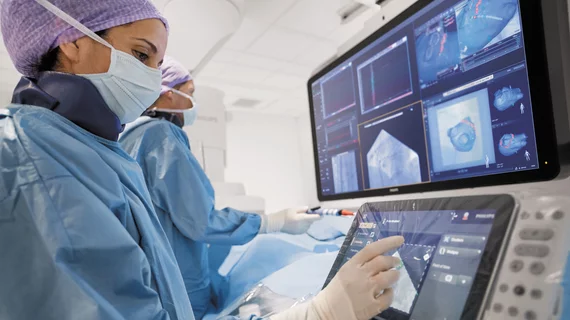Radiology, other multispecialty groups urge caution with GBCAs during interventional pain procedures
In some patients, the use of gadolinium-based contrast agents during interventional pain procedures has been associated with brain retention and damage and, in some extreme cases, even death. In light of known and emerging concerns, a group of multispecialty organizations recently released a practice advisory for physicians.
The American Society of Regional Anesthesia and Pain Medicine, Society for Interventional Radiology, American Society of Neuroradiology and seven other top groups contributed, sharing their guidance Thursday in Anesthesia & Analgesia. The evidence-based recommendations are meant to help physicians better select GBCAs and manage adverse events.
Typically, doctors utilize iodinated contrast to guide drug delivery to specific tissues or places in the body. Some patients are sensitive to ICMs, however, forcing interventionalists to use GBCAs.
But the authors have noticed three new developments impacting continued gadolinium contrast use, including nephrogenic systemic fibrosis (NSF) in patients with preexisting renal disease, gadolinium deposition/retention in the brain from repeated administration, and encephalopathy from unintentional intrathecal (IT) injection.
“Appearance of these new reports of previously unrecognized adverse events resulted in calls for caution in the continued use of GBCA, an informed discussion with the patient, and the creation of a guideline,” Honorio T. Benzon, MD, of Northwestern University Feinberg School of Medicine’s Department of Anesthesiology, and colleagues explained April 1.
As part of their process, a leader and 2-3 other members were assigned to each of the three aforementioned topics, along with rare breakthrough hypersensitivity reactions after exposure to a contrast. Those individuals were either an anesthesiologist, radiologist, or a physical medicine and rehabilitation specialist. The teams pored over literature published on these topics through Dec. 31, 2019.
For each of the four events, the experts provided a statement, recommendations and corresponding letter grades indicating their confidence level.
Overall, Benzon and colleagues acknowledged “there is no ideal GBCA.” NSF and gadolinium retention are less of a problem during interventional pain procedures, they added, but encephalopathy after unintentional gadolinium injection remains a “grave concern” for interventionalists, they warned.
Other groups contributing to this document included the American Academy of Pain Medicine, the British Pain Society, the Canadian Pain Society, the European Pain Federation, the Korean Pain Society, the Spine Intervention Society, the World Allergy Organization, and the World Institute of Pain.
Read the practice advisory in its entirety here.
Related MRI Contrast Agent Safety Content:
A deep dive into gadolinium-based adverse reactions
Allergic reactions to iodinated CT contrast increase likelihood of sensitivity to GBCAs
Researchers detail data on gadolinium-related adverse reactions
Radiologists must take a data-driven approach to discuss gadolinium, mitigate liability risk
Radiologists see potential to reduce GBCA administration with new synthetic MRI technique
Gadolinium-based contrast agents are safe, even at higher doses, new research suggests
Gadolinium debate rages on, with radiologist questioning recent GBCA liability guidance
ACR committee proposes new term for symptoms associated with gadolinium exposure
Closing the knowledge gap on gadolinium retention risks
Radiologists find direct evidence linking gadolinium-based contrast agent to higher retention rates
AI software that eliminates need for gadolinium contrast during imaging exams wins patent
Research may offer new method to detect GBCA on MRI
Health orgs publish special report about gadolinium retention, GBCA use in imaging
Rodent brains retain gadolinium after repeated administration of GBCA a year after injection
Advanced MRI mapping spots traces of gadolinium in the brain invisible during conventional scanning
Radiologists should keep patients’ best interests in mind to mitigate gadolinium liability risk

